The magnificent Cathedral of Orvieto stands at the center of the city of which it is the symbol. The Cathedral tells with each of its stones centuries of history: in fact, it is a precious treasure chest containing countless treasures, from the façade to the frescoes, statues and panels contained within. In 1290, following the decision to build a large cathedral to replace those already on the square, work began on the construction of Orvieto Cathedral. The building site started under the direction of the master builder Fra’ Bevignate, but the construction work lasted five long centuries, in which numerous architects followed one another. In 1309 the work was entrusted to Lorenzo Maitani, an architect and sculptor from Siena, to whom we owe the present Gothic facade. After his death Andrea Pisano was appointed master builder, who was succeeded by Andrea di Cione known as l’Orcagna, who created the magnificent rose window.
The cathedral has a Gothic-style facade consisting of four buttresses ending in spires that divide it into three sectors. Work on the facade began at the same time as work on the body of the building, with Romanesque forms, but with Maitani’s direction, Gothic elements were incorporated. Together with his son Vitale Maitani, the architect and sculptor created the marble Virgin and Child, placed in the lunette of the central portal (now preserved in the Museo dell’Opera del Duomo in Orvieto and replaced on site by a copy), and the four statues placed on the cornice of the pillars on either side of the portals, representing respectively theAngel, the Lion, theEagle and the Bull, that is, the symbols of the four evangelists (Matthew, Mark, John and Luke, respectively). Carved on the base of the four pillars placed on the facade are bas-reliefs depicting Stories from the New and Old Testaments, following the theme of human history from the origins to the apocalypse. In the first two bas-reliefs we have stories from the Old Testament, while in the third we have stories from the New Testament with the Nativity, the Flagellation of Christ, and the Massacre of the Innocents, and in the fourth and last we have the Last Judgment.




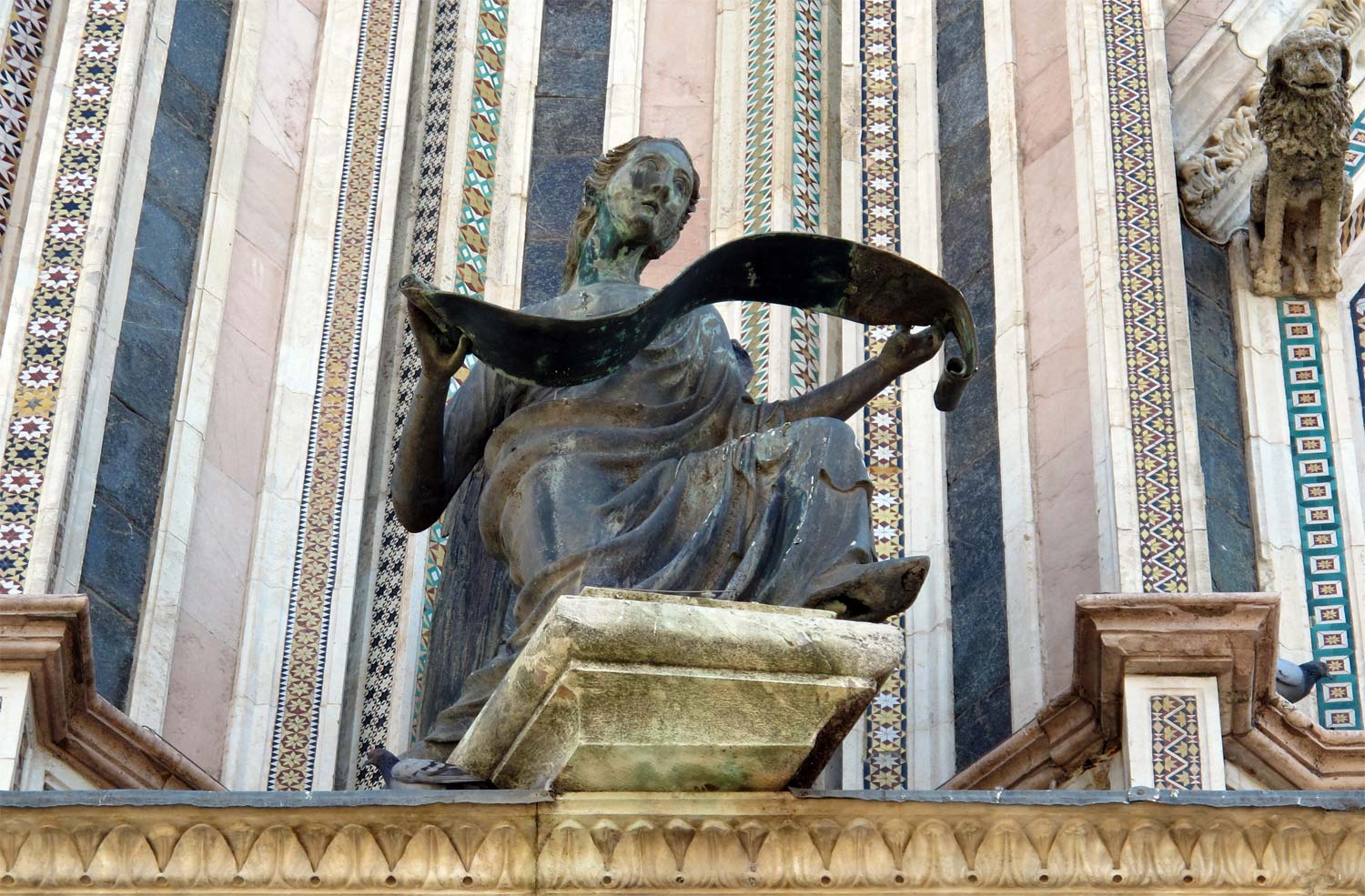
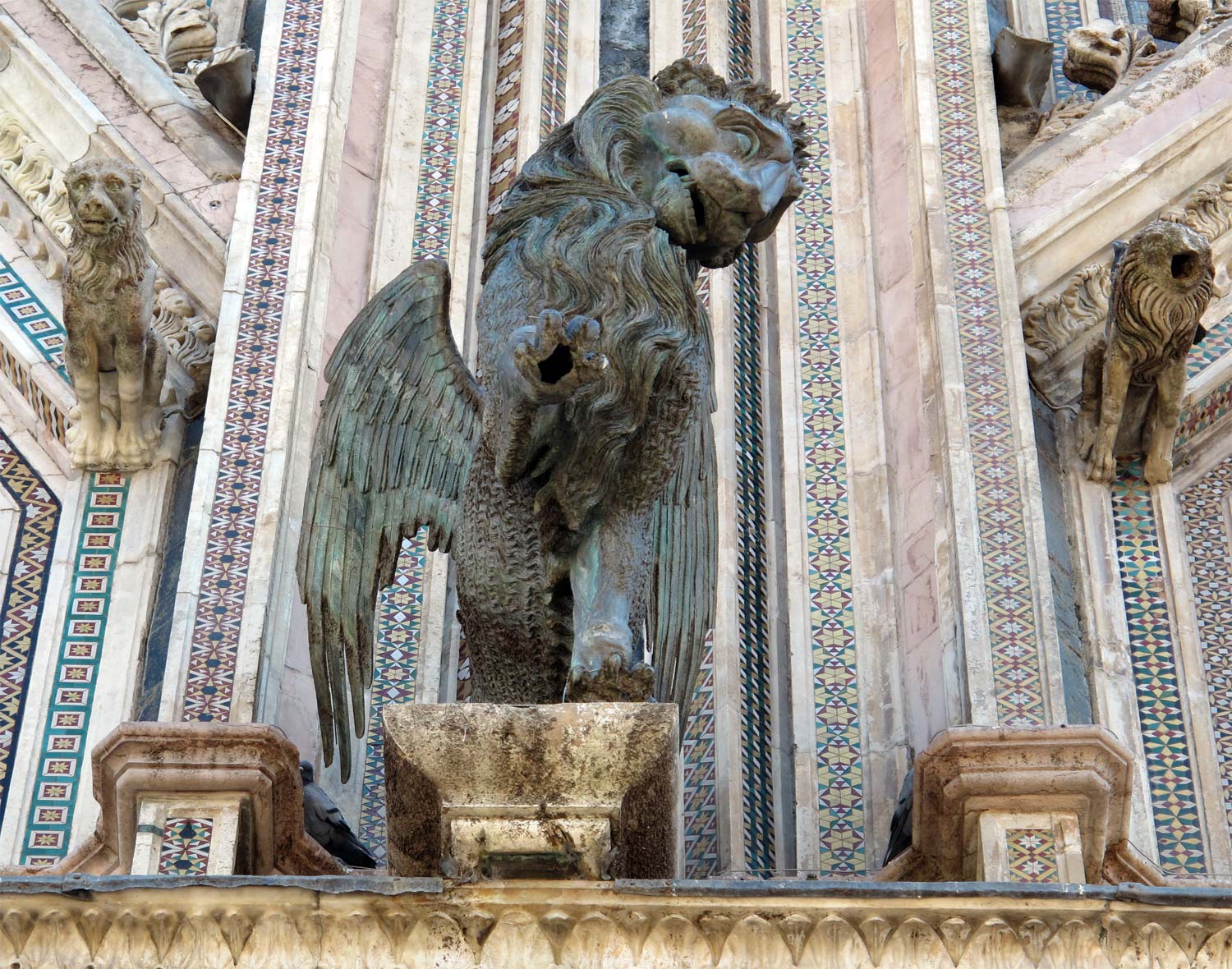
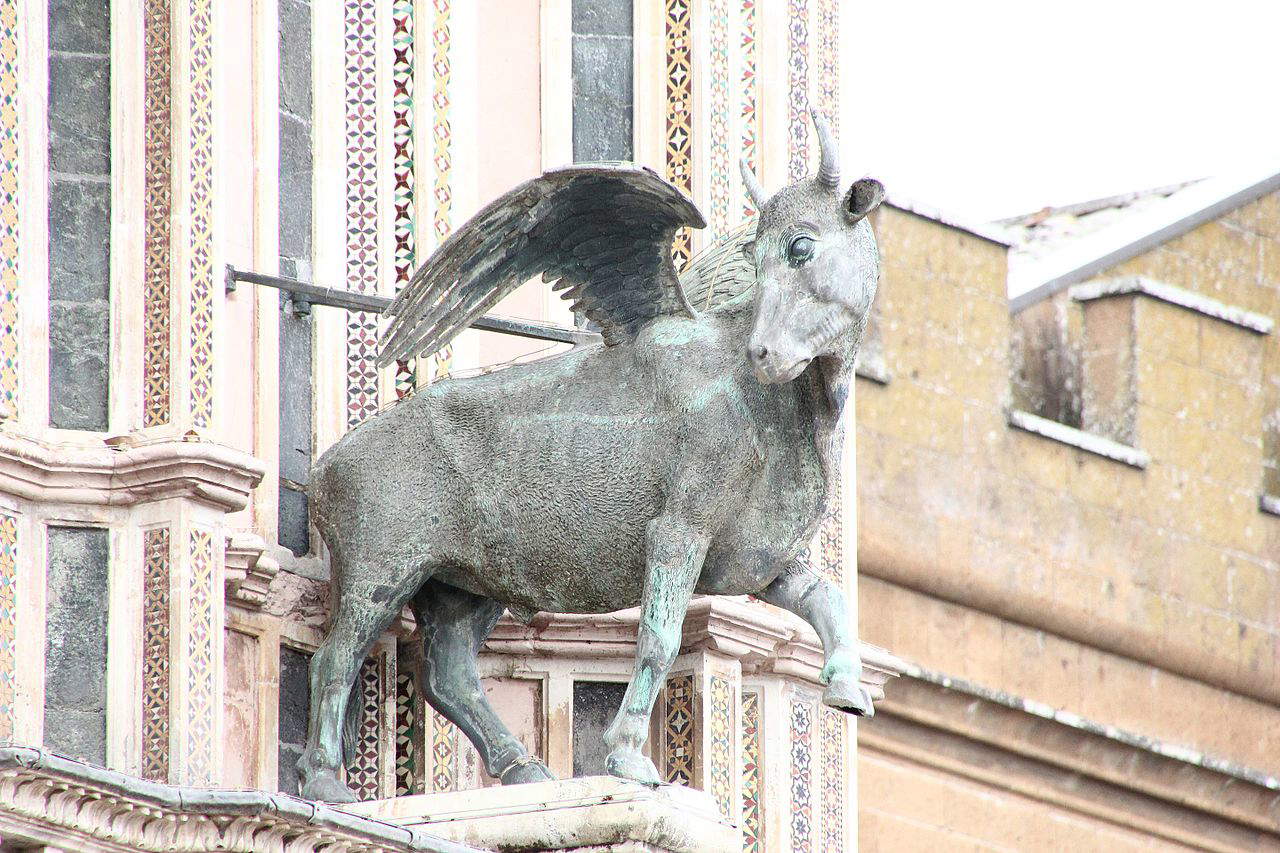
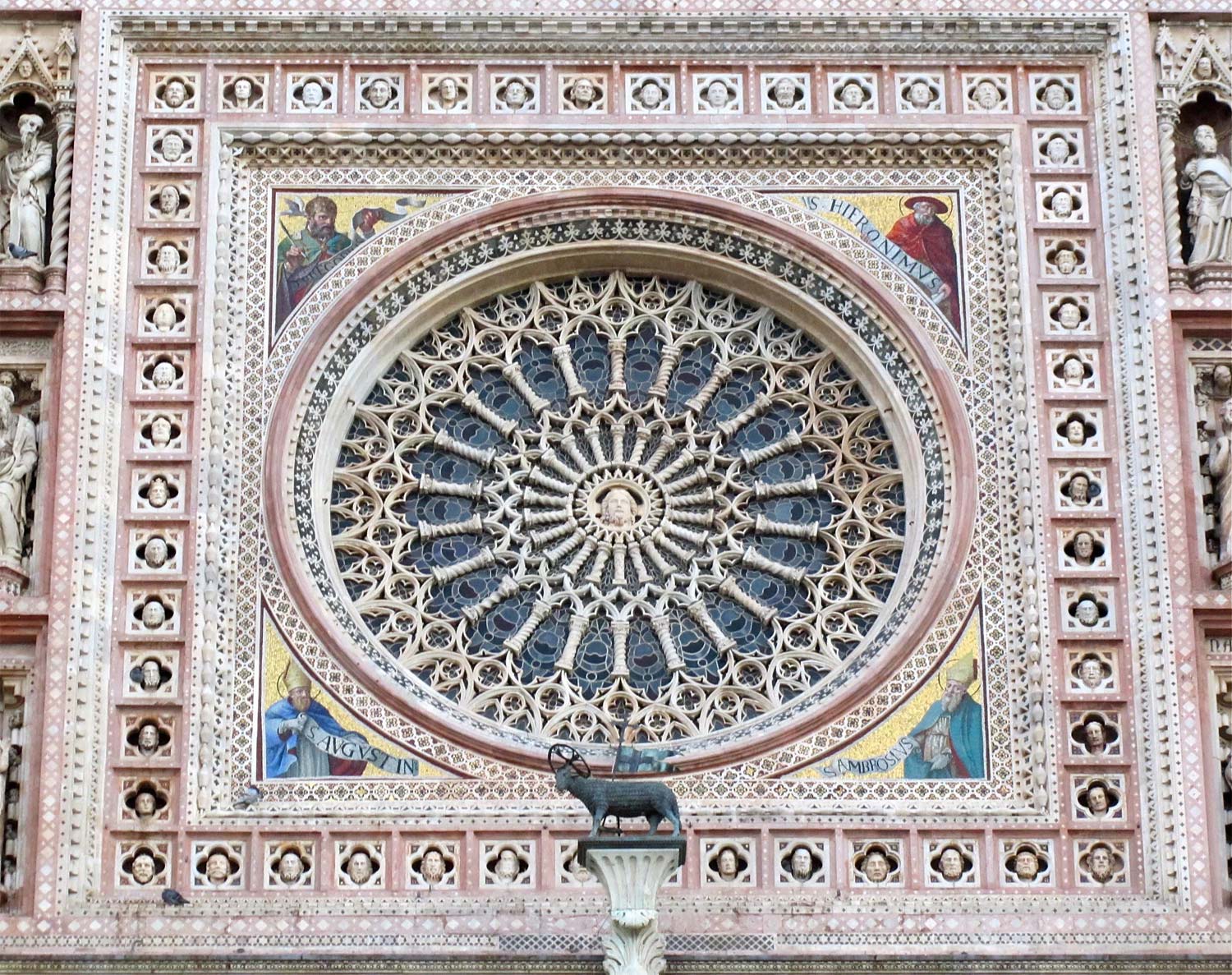
Embellishing the facade of the cathedral are the splendid mosaics, created on a gold background, depicting the main episodes in the life of the Virgin, for whom the cathedral is named. Placed in the side tympanums are theAnnunciation to Anna, the Birth of the Virgin, the Presentation in the Temple, and the Marriage with Joseph, while in the center are depicted the episodes concerning the Madonna’s ascent from earth and her triumph in heaven. The only episode that is detached from the main theme is the Baptism of Christ, which can be seen under the tympanum on the left. The very expensive mosaic decoration was a source of pride for the city, and a kiln was even built on the site in order to make the necessary tiles. These were originally treated to resemble alabaster, but over the centuries they have been replaced or undergone major restoration.
Catching the eye is the rose window placed in the center of the mosaics, made between 1354 and 1380 by the sculptor and architect Andrea Orcagna. The face of Christ, placed in the center, is surrounded by a register of interlaced colons and arches. At the four outer corners the rose window is embellished with mosaics made by painter Piero di Puccio, representing the four Doctors of the Church St. Augustine, St. Gregory the Great, St. Jerome and St. Ambrose. The whole is framed by travertine sculptures and heads, while at the side aedicules made by Petruccio di Benedetto da Orvieto house 13 statues of prophets. The upper ones, made by sculptor Antonio Federighi, house statues of the 12 apostles To enter the cathedral one passes through bronze doors by sculptor Emilio Greco, decorated with reliefs representing the Works of Mercy, which have replaced the original wooden ones since 1962.
The interior is very sober, and the plan consists of three naves divided by ten cylindrical columns and two octagonal pillars. The cathedral is decorated with numerous fresco cycles, such as the one by Ugolino di Prete Ilario, with Stories of the Virgin, placed in the apse. Near the high altar, from 2019 returned to its original location in the cathedral, we find theAnnunciation by Francesco Mochi, composed of two statues, namely theAnnouncing Angel, made life-size as she descends in flight from Paradise, and the Virgin, larger than life-size, inspired by Michelangelo’s statue of Rachel , with similar dimensions. Also in 2019, 122 years after their removal, the monumental statues of saints and apostles made by various artists (Moschino, Raffaello da Montelupo, Ippolito Scalza, Giovanni Caccini, Pietro Francavilla, Francesco Mochi, Ippolito Buzi, Bernardino Cametti, and Fabiano Toti) between 1556 and 1722 returned to Orvieto Cathedral, and relocated about eight months after Mochi’sAnnunciation . Moving to the left arm of the transept we admire a Pietà made by Ippolito Scalza. Commissioned by the Opera del Duomo between 1565 and 1570. the work, made ex uno tombstone, consists of four figures: the Virgin holding the body of Christ, Nicodemus and the kneeling Magdalene. The artist, who signed the statue on the plinth, had the privilege of choosing the subject himself, and created this group with an iconography that lies somewhere between a pietà and a mourning over the dead Christ. The Michelangelo inspiration is evident, however, both in the choice of theme and in the execution. Scalza himself made the monumental pipe organ placed above the entrance arch of the Corporal Chapel.
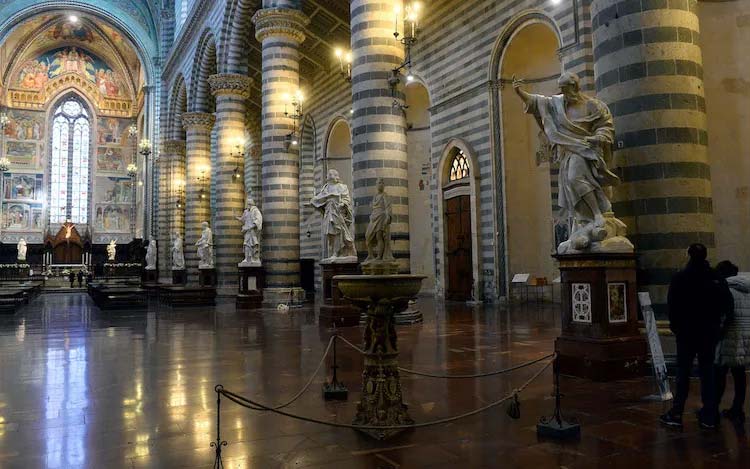


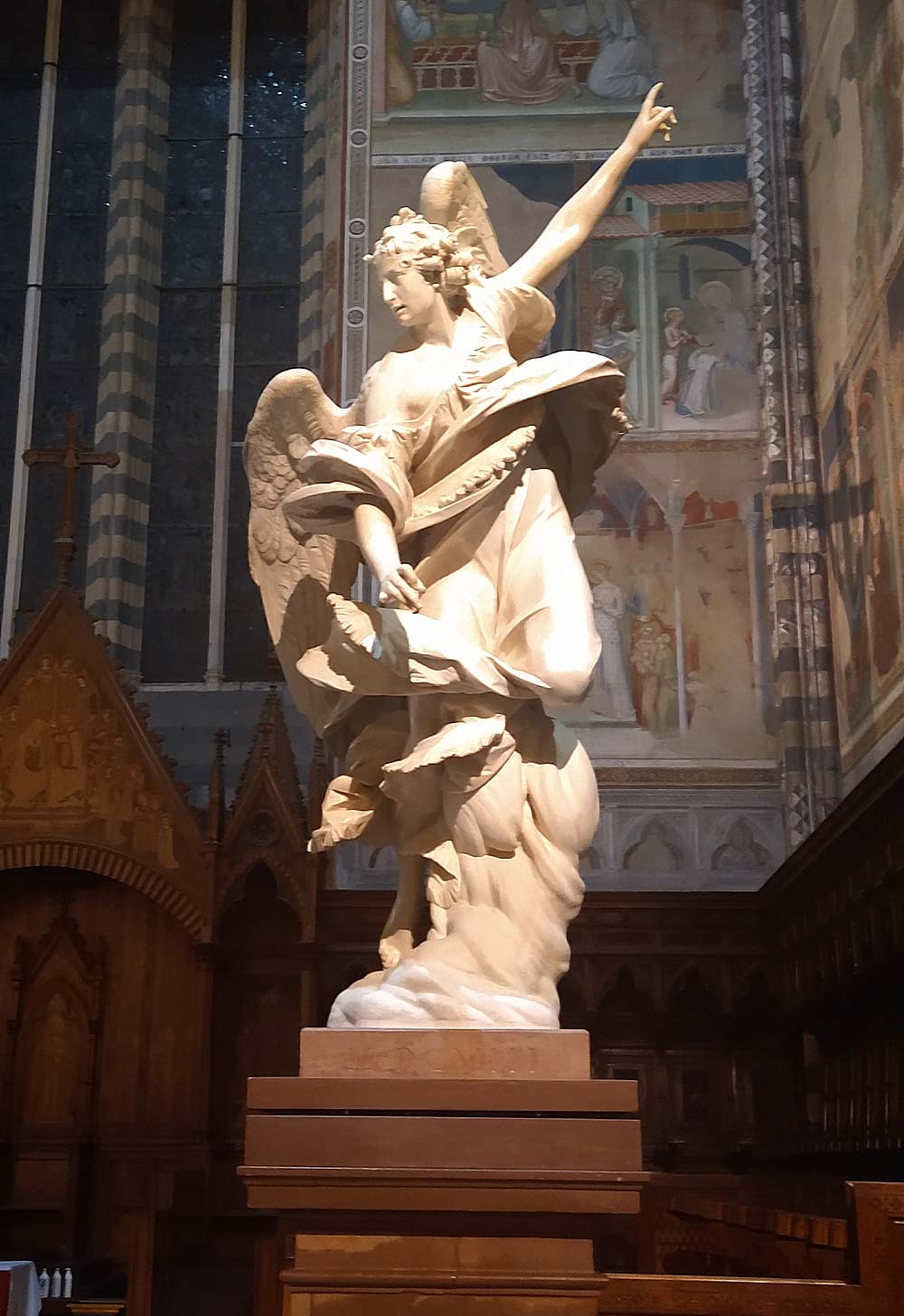

Between 1350 and 1356, under the direction of Andrea Pisano, the Chapel of the Corporal was built in the left transept. Built on the rampant arches made by Maitani to support the building, it was created to preserve an important relic, the corporal stained with the blood of Christ during the Miracle of the Bolsena Mass. The miracle occurred when a Bohemian priest, who had begun to harbor doubts about transubstantiation, made a pilgrimage to Rome in the hope of clarifying his doubts, and on the way decided to celebrate a mass in Bolsena. During the Eucharist, blood oozed from the host, dispelling all the celebrant’s doubts and staining the corporal.
The Miracle of Bolsena and the theme of transubstantiation are the main themes around which the pictorial decoration of the chapel revolves, created by Ugolino del Prete Ilario between 1357 and 1364, with the help of collaborators such as Giovanni di Buccio Leonardelli, Petrucciolo di Marco, Domenico di Meo, Antonio di Andreuccio and Pietro di Puccio. The precious relic was kept in the reliquary that the bishop of Orvieto, Beltramo Monaldeschi, commissioned from the Sienese goldsmith Ugolino Vieri. It was made when it was decided to revive the feast of Corpus Christi, the reliquary in fact would be carried through the city streets, with the host and holy cloth inside. Standing 139 centimeters tall and 63 centimeters wide, the reliquary is made of gilded silver and mercury, and decorated with translucent enamel on embossed silver and embellished with large cabochon-cut stones. It is punctuated by four hexagonal pillars, like the facade of the cathedral itself. In the thirty-two painted enamel panels we find the story of the Eucharistic Miracle of Bolsena and the Stories of the Passion of Christ.
Also in the chapel is the altarpiece with the Madonna dei Raccomandati by Lippo Memmi, probably made before 1320. Previously kept in the fourth chapel of the right aisle, it is now in the Chapel of the Corporal from 1573. The altarpiece, of great refinement, depicts the Virgin, dressed in a cloak of Vaio fur, which stands out against the gold background; at the center six her feet can be seen the artist’s signature. Beneath Mary’s mantle, to her right, men are depicted, while to the left are seen the sisters, including two noble maidens adorned with crowns, to whom are mirrored the young men dressed in bourgeois robes and wearing fur headdresses. The 18 angels are arranged symmetrically on either side of the virgin, and two of them hold her cloak.

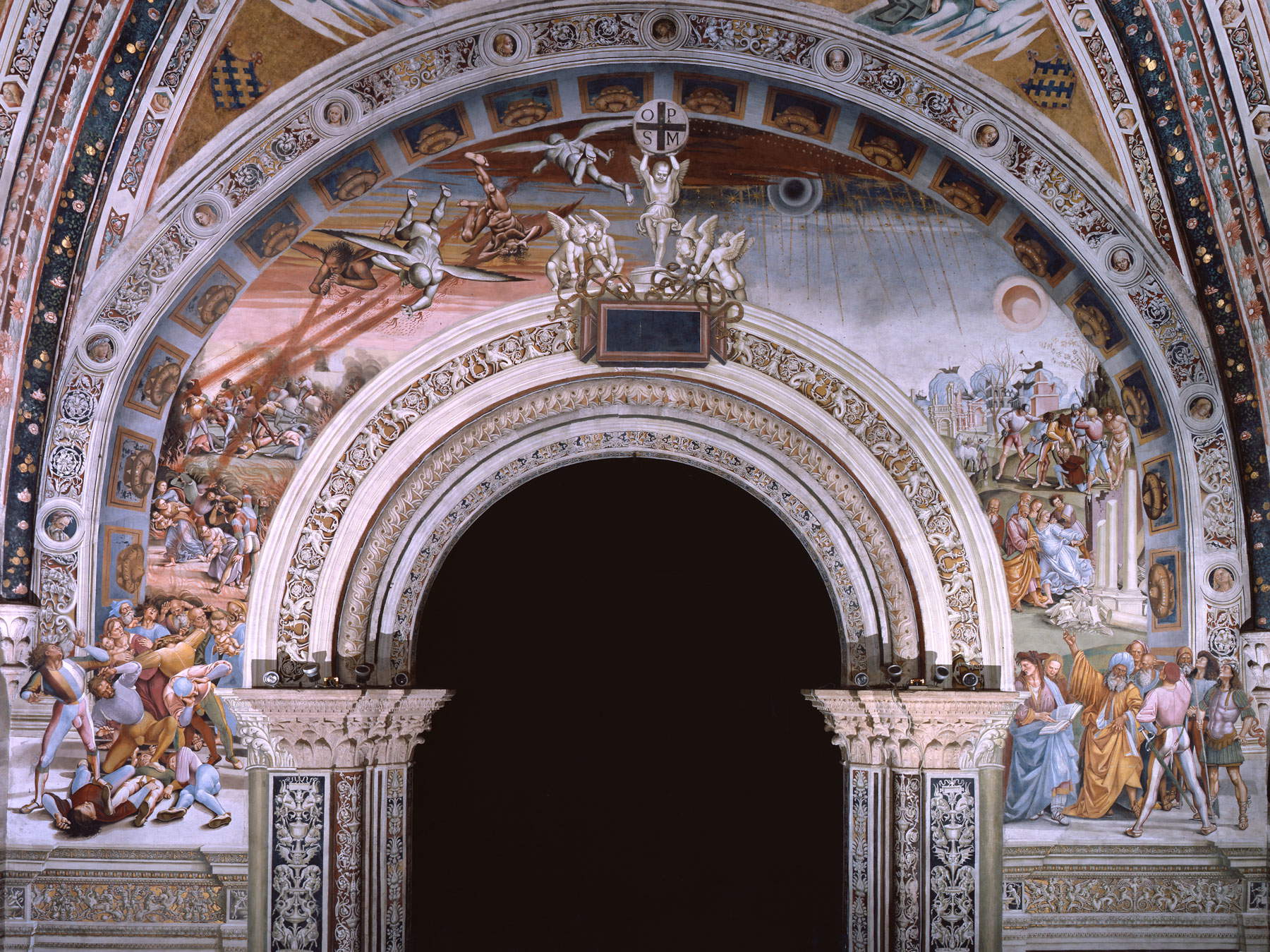
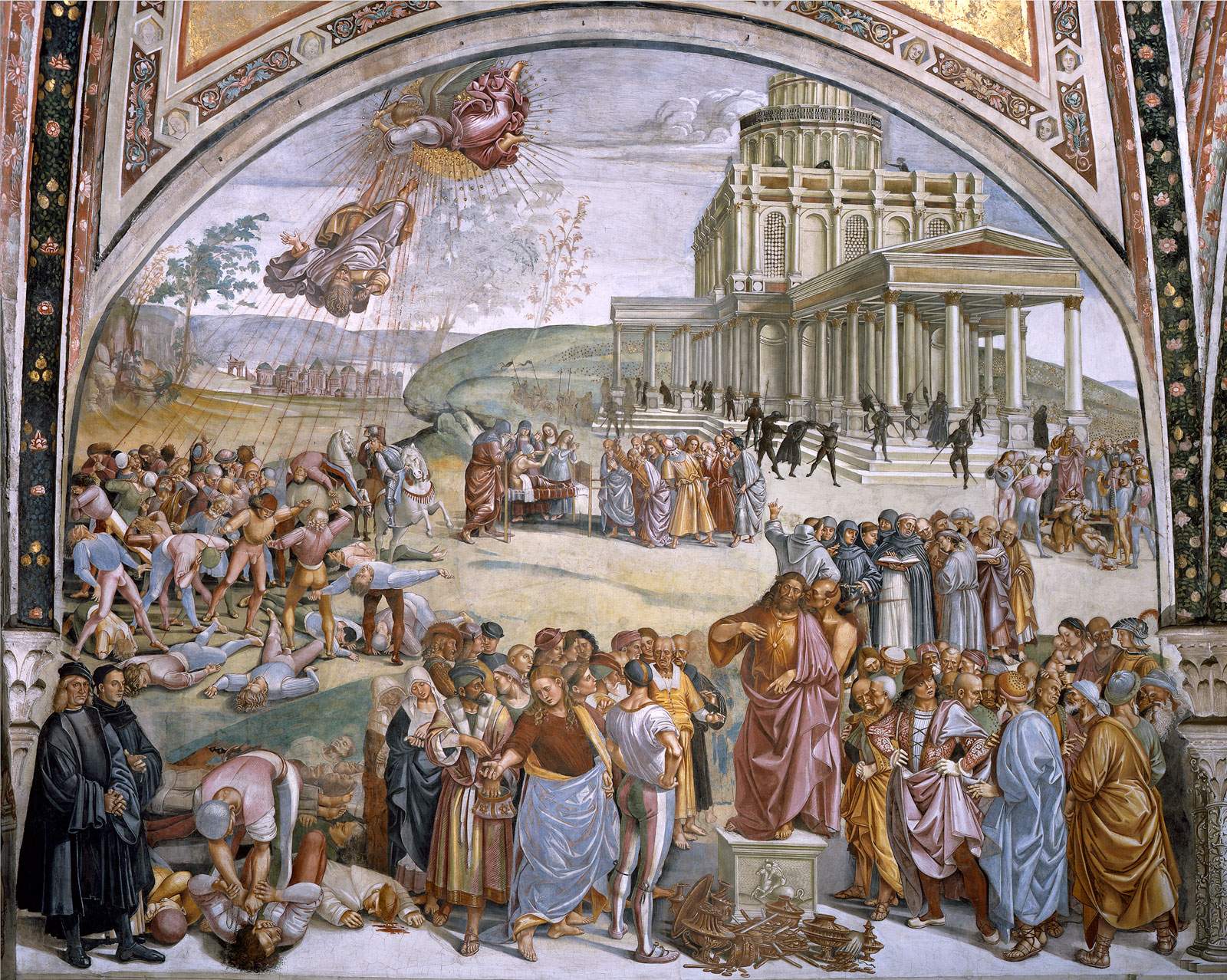
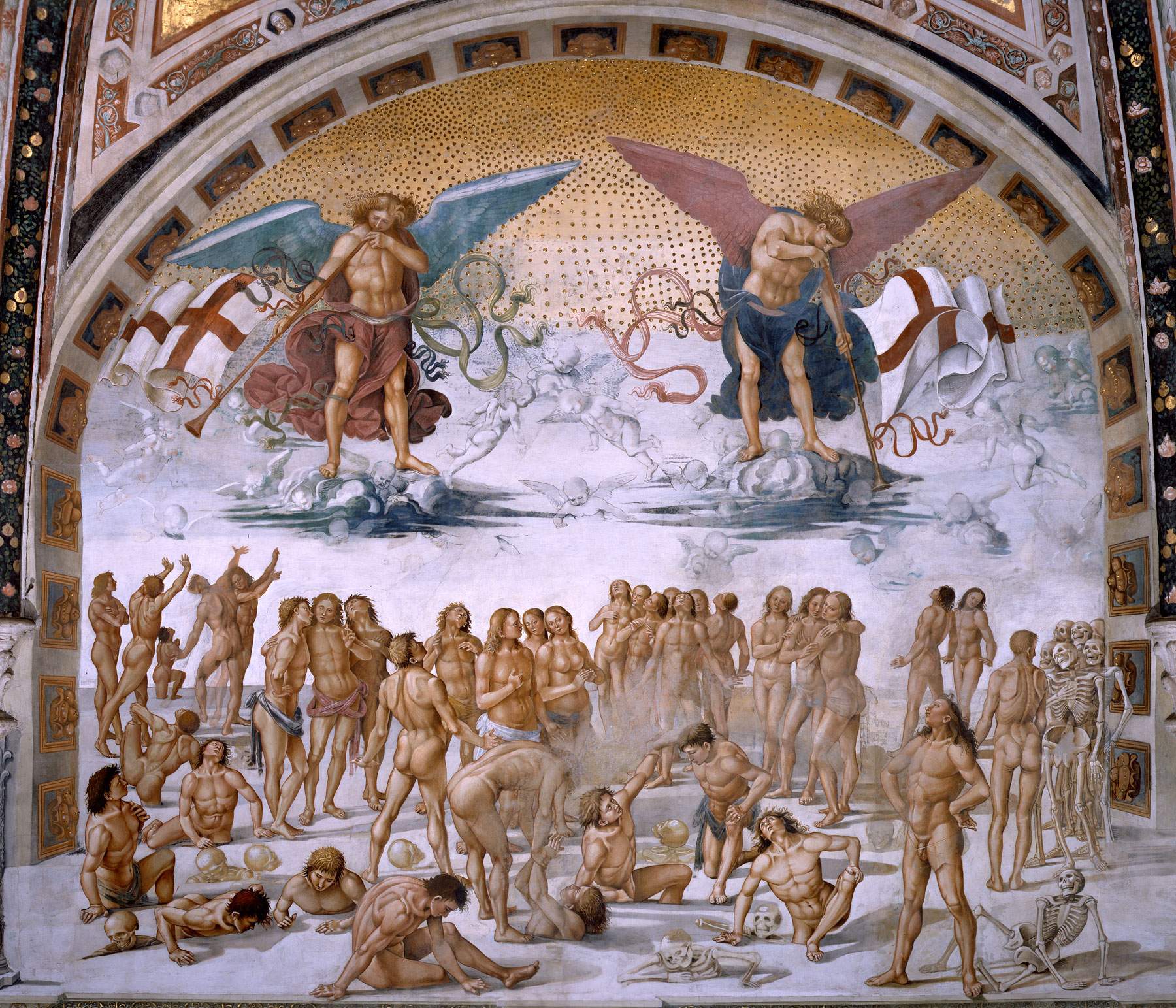


In the Duomo finds its place, opposite the Chapel of the Corporal, the Chapel of San Brizio, built starting in 1396. Initially the decoration was entrusted in 1447 to Beato Angelico and his collaborators, among whom was Benozzo Gozzoli. However, only Christ the Judge and the Prophets in the sail were realized. Later the Opera del Duomo tried to hire Perugino, but after this engagement failed the decoration was entrusted to Luca Signorelli. The first contract, dated April 5, 1499, called for the artist to paint the unfinished vault following Angelico’s drawings. Given the satisfaction with the result and the speed with which it had been achieved, a second contract was then made, in which Signorelli undertook to decorate the entire chapel with a predefined program, the result of collaboration between the artist and the city’s theologians. The Martyrs, the Virgin, the Patriarchs and the Doctors of the Church were depicted on the ceiling sails of the entrance. Between 1499 and 1504, on the other hand, the Stories of the Antichrist, the Finimondo, the Resurrection of the Flesh, Hell, the Antinferno, the Calling of the Elect, and Paradise were made, set within a large and scenic architectural structure.
Of great impact is the scene with the Acts of the Antichrist, where the devil’s physiognomy is very reminiscent of that of Christ, if not for the wicked gaze, for the particularity of the iconographic choice and theme, which belong to the figurative tradition beyond the Alps. In the chapel, amid scenes that seem more alive than ever before, we find ourselves in the midst of the struggle between heresy and faith, between evil and good, and between fear and compassion the viewer finds hope through the message of salvation and redemption that is made possible by Christ’s sacrifice.
The Duomo is located in the center of the city, and just outside the train station is the cab zone, bus information point, and funicular, which runs every 15 minutes and stops in the Piazza del Duomo. For those arriving by car, it is advisable to park outside the historic center and continue on foot. Timetables and ticket costs can be found on the official website.
Warning: the translation into English of the original Italian article was created using automatic tools. We undertake to review all articles, but we do not guarantee the total absence of inaccuracies in the translation due to the program. You can find the original by clicking on the ITA button. If you find any mistake,please contact us.